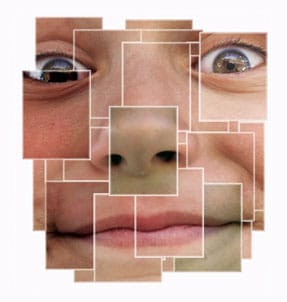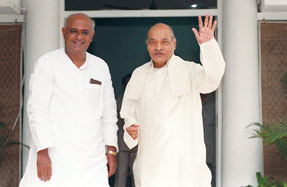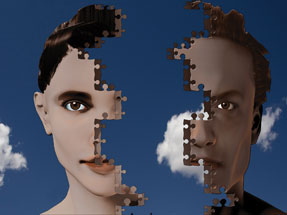Magazine
Fair and Ugly

The disclosure in the national bestseller Game Change that Senate majority leader Harry Reid once remarked that then presidential candidate Barack Obama would be embraced more easily by Americans because he was “light skinned” and didn’t have a “Negro dialect, unless he wanted to have one” touched off a political firestorm on race in the United States. While the comments, for which Reid apologized profusely, were denounced as racist in many circles, there is also widespread acknowledgment that, however indelicately, Reid had lifted the lid on a painful truth endemic to American political life.
Shankar Vedantam, author of The Hidden Brain: How Our Unconscious Minds Elect Presidents, Control Markets, Wage Wars, and Save Our Lives, says Reid’s observation is no more “controversial than saying wealthy people have an advantage in elections.” Vedantam wrote in the New York Times, “Dozens of research studies have shown that skin tone and other racial features play powerful roles in who gets ahead and who does not. These factors regularly determine who gets hired, who gets convicted and who gets elected.” Extensive research in the United States has documented implicit and explicit bias based not just on race, but also skin tone — what anthropologists call “colorism,” described by the researchers Keith Maddox and Stephanie Gray as “the tendency to perceive or behave toward members of a racial category based on the lightness or darkness of their skin tone.” Thanks to their economic success, driven in large part by their higher educational attainment, Indian Americans — who are three times as likely to have a college degree than Whites and five times as likely to have a graduate degree — have avoided many of the burdens of their skin tone in American life. Ironically, however, few communities worldwide demonstrate as deep a prejudice for light skin as Indians.
Consider that Emami’s skin lightening cream Fair and Lovely for women racked up $325 million in sales in India last year. L’Oreal recently rolled out Bollywood hunk John Abraham to pitch its Garnier Men’s skin whitening lotion to challenge the hegemony of the market favorite Fair and Handsome, whose pitchman Shah Rukh Khan is one of India’s hottest filmstars. Advertising spending on skin whitening products grew almost 30 percent in 2009 over last year and Unilever’s Vaseline Healthy White Body is currently the most advertised cosmetic brand on Indian television. Perhaps the most compelling evidence of the Indian obsession for fair skin comes from a Little India analysis of matrimonial ads on one of India’s largest matrimonial website, BharatMatrimony.com, which found (see box) that in a strong majority of profiles, users self identified themselves as fair or very fair and just 2% classified themselves as dark. Even a majority of South Indians, who are decidedly darker than North Indians, categorized themselves as fair or very fair and just 2% as dark. The study also found that the encounter with America’s predominantly white culture heightened the self identification with fair skin among Indian Americans, who categorized themselves as “very fair” in somewhat higher proportions than people in India.
The U.S. civil rights movement wrought a sea change in race relations and overt expressions and acknowledgment of racial prejudice in public life are now rare. However, an accumulating corpus of research evidence demonstrates that Americans continue to harbor deep seated biases on issue of race and skin tone, cultivated by decades of conditioning and even centuries of evolution. Since 1998, researchers at Harvard University’s Project Implicit website (see box) have compiled data on the implicit biases of millions of Americans (and in more recent years other parts of the world) on a range of issues, such as age, race, skin tone, disability, gender, sexual orientation, etc. The bias is assessed on the basis of individual responses to rapid word association tests administered on the website. Asians demonstrated the highest levels of bias on race and skin tone than people of any other region in the world and Asian Americans were second only to Whites in their bias in these racially and ethnically sensitive categories. Moreover, Asians and Asian Americans reported the highest level of explicit prejudice on issues of race and skin tone — higher than even Whites — on the Harvard website. Harvard University’s Mahzarin Banaji, one of the three authors of the Implicit Association Test (IAT), who grew up in India, said that resource limitations precludes her research group from analyzing their data from India and South Asians: “In the future, we will have the resources to look at these data by various subgroups around the world. It is an interest of mine to look at this result from Indians, in part because of my experience, that in India (and a few other cultures) skin color is coded far more finely that in simple dark-light form.” Nevertheless, Banaji points out, her research has found that the implicit bias for lighter skin tone is consistent across all U.S. racial groups. There is broad agreement, although by no means unanimous, in the scholarly community that most people hold unconscious biases on matters of race or skin tone. But more significant than the fact that almost 70 percent of the millions of people who have taken the IAT demonstrate at least some preference for light skin is the real world impact of such biases. There is mounting evidence of the social, economic and political disparities that colorism engenders, often as striking as disparities based on race. A study by HarvardUniversity’s Traci Burch of nearly 67,000 convictions of first time felons in Georgia between 1995 to 2002, for instance, found that blacks on average received sentences that were 378 days longer than Whites. But Burch also found wide disparities based on the skin tones of Black defendants. The sentences of the lightest skins Blacks were three and half months longer than Whites, those of medium skinned Blacks were a year longer than Whites, while the sentences of dark skinned Blacks were a year and a half longer than Whites. Another study by Stanford psychologist Jennifer Aberhardt and her colleagues, Paul Davies, Valerie Purdie-Vaughns and Sheri Johnson, of capital cases between 1979 to 1999 from Philadelphia, Penn., found that dark skinned Black defendants in crimes involving a White victim were twice as likely to receive the death penalty than lighter skinned Blacks. Likewise, research by Jennifer Hochschild, Traci Burch and Vesla Weaver, of the government department of Harvard University, demonstrated that light skinned Latinos and African Americans had two years of additional schooling than dark skinned ones. They also found that light skinned Blacks earned almost $2,695 more than dark skinned Blacks while light skinned Latinos earned $3,163 more than dark skinned ones. Other research suggests that the wage gap is even wider — as much as $5,000. A University of Georgia study established that hiring managers preferred light skinned Black job applicants to dark-skinned ones. The researcher Mathew Harrison concluded: “Dark-skinned men with greater credentials were significantly less preferred than a light-skinned man with lower credentials. The economic gap between light-skinned and darker-skinned Blacks is similar to the gap between Whites and Blacks.” Research also offers compelling evidence for Reid’s politically sensitive remark that lighter skinned Blacks have better electoral success than dark skinned ones. A 2007 Harvard study, “The Skin Color Paradox and the American Racial Order,” on Black officials elected to statewide or national offices since 1865 found that 40% were light skinned and 20% dark skinned, against a national Black population that is 17% light skinned and 38% dark skinned. More bluntly: a light skinned Black was four times as likely to be elected than a dark skinned one in proportion to their relative representation in the U.S. population. These burdens of dark skin tone have profound implications for Asian Americans, whose higher educational attainment levels have allowed them to dodge the hurdles of race that have tripped up other U.S. minorities. And the pernicious consequences of skin tone biases entrap Asians, such as Indian Americans, not just with the dominant American White culture, but within their own subethnic group as well. Says Vedantam: “Colorism is an intraracial problem as well as an interracial problem. Racial minorities who are alert to white-black or white-brown issues often remain silent about a colorism that asks ‘how black’ or ‘how brown’ someone is within their own communities.” The 1995 Federal Glass Ceiling Commission noted: “Color-based differences are inescapable, but nobody likes to talk about them…. Though it is mostly covert, our society has developed an extremely sophisticated, and often denied, acceptability index based on gradations in skin color…. It is applied to African Americans, to American Indians, to Asian and Pacific Islander Americans, and to Hispanic Americans.” Unfortunately, most research on skin tone has focused exclusively on African Americans and Hispanics, often because the sample sizes for Asians are small. It is driven also by, what Brian Nosek, a researcher at the University of Virginia in Charlottesville, Va., and another author of the IAT, views as an “obsession” of U.S. culture with race issues surrounding African Americans. Says Nosek: “That is one gap I would like to see start to close as the world is becoming flatter.” But even in the absence of research specifically targeting the impact of skin tone bias involving Indians, Vedantam says, “I have no doubt that the same phenomenon applies in India that given two Indians or two Pakistanis, skin tone does matter in all kinds of different ways — whether someone gets hired for a job, whether they are suitable for promotions, perhaps in the criminal justice systems, what kind of punishment someone gets for committing a crime.” Given the near universal consistency in the automatic preference for lighter skin in the skin tone test, the “results seem to be quite general,” says Banaji. Among Indians, Banaji says, the implicit bias is compounded by “an explicit and blatant preference for lighter skins” as well. As a result, says Vedantam, “I would expect that the same phenomenon would hold true (among Indians) that whiteness is so prized not only in matrimonial ads where people seek out fair skinned brides and bride grooms but all kind of domains professional domains, law, medical treatments, who gets access to treatment and who does not.” Indeed, the pernicious consequences of the preference for lighter skin tone could be even acuter among Indians. Nosek says he find the fact that Asians report the highest level of conscious bias for lighter skin tones “curious and I do not have an answer based on evidence” for it. “I can only offer speculation and perhaps the main speculation would be that in the category of Asians there may be more variation in skin tone than there tends to be on other sub groups and they may be culturally more valuing lighter skin tones. This is certainly true in South America and in India as well where lighter skin tone tends to be more highly valued or associated with more highly valued groups. There may be an interesting sociological or historical factors for that valuation.” The matrimonial market and the still widespread practice of dowry makes India among the few countries where a direct monetary value can be ascribed to fair skin, unlike in the United States, where it is mediated through economic or judicial disparities. Banaji recalls “being told by a friend when I was in college in India in the 1970s that she would fetch Rs 10,000 more in dowry than her sister who looked the same as her in skin color, but who was apparently a shade darker than my friend.” Banaji adds: “We have to ask why, and what it means about our values, and how we can each take actions that promote people based on the content of their character, on their abilities and contributions, rather than on pigmentation.” Sunaina Maira, associate professor of Asian American Studies at the University of California, Davis, says: “I think this issue (of pigmentation) impacts every area of life. It’s most explicitly expressed in relation to marriage, but it surfaces in family relationships, gender relationships, employment, social life, popular culture, youth culture, etc. Indians who have color prejudice express it in every arena, not just marriage, and so people are constantly ranked and evaluated according to color. It’s also evident that Bollywood actors and actresses are increasingly not just light-skinned but also light-haired and lighter-eyed, and more Caucasian-looking in their facial features as well (cosmetic surgery is also on the increase, as are colored contact lenses).” India Today recently reported that fair-skinned prostitutes from Azerbaijan, Chechnya, Georgia, Kazakhstan, Kyrgystan, Ukraine and Uzbekistan “feeding on the Indian fascination for white skin,” have taken over the high end flesh trade in the country. Sarah, a prostitute from Tashkent, told the magazine, “Indians are so conscious of their colors and ours,” while, Pramada Menon, a Delhi-based community activist on gender issues, said: “Sex with light skinned women is aspirational” for many Indians. Maira says the Indian attitude doesn’t just stop at a preference for light skin; they discriminate against those with dark skin: “This also leads to racism against Africans and others with dark skin. There was a recent article by an African American recounting his horrendous experiences traveling in India. We fawn over white foreigners and treat dark or black foreigners terribly.” Madhulika Khandelwal, director of the Asian American Center at QueensCollege, argues that India’s cultural diversity, however, diffuses the impact of skin tone, so that it may not have quite the impact that racial categorization and institutionalization of racial categories in the United States do. Even though Indian Americans, for example, self identify themselves as fairer than people in India, that attitude likely plays out in the context of the dominant culture than within the community, where “it may take the edges off or soften the boundaries within the group.” Khandelwal said while she had found anecdotal discussions of the impact of skin tone in India and the Indian American community, she has not seen any empirical work on the subject. Nearly a dozen scholars in the area of Indian American, race and ethnic studies polled by Little India were likewise unaware of research work in this area. As the academic study of Asian Americans expands on U.S. college campuses it is a subject that likely will receive increasing scrutiny in the coming decade. Meanwhile, Vedantam says the strongest bulwark against unconscious biases is to become aware of them by taking psychological tests, such as the IAT, “If we don’t even know that they exist they will have complete sway over us, manipulating us.” Nosek adds that “awareness” in turn would lead to greater humility in recognizing that our judgments may be impaired by biases, prodding us to reevaluate our assumptions on issues. Implicit biases, as opposed to conscious biases, are most likely to influence behavior, Nosek says, when the decision is complex, ambiguous or when people are under stress or have to react quickly. “When those factors are at play we can fall back on our heuristic easy way of thinking and may not be likely to notice the potential impact of implicit bias on our judgment.” In those circumstances, Nosek suggests, people “deliberately slow down or seek a second opinion and do other things that might help to reduce the potential impact of implicit bias.” But individual efforts can only go so far, Vednatam says, arguing that we need societal and institutional responses to our implicit biases: “We can construct institutions that can essentially protect us from our own hidden brains…. At an institutional level we can make sure that we have systems that can check on us — integrity checks that can establish that the outcomes of what we are doing are fair and accurate.” Banaji cautions that pigmentation based discrimination is only a part of the larger emphasis on outward beauty. She recalls a friend in Mumbai who was told by her manager at a prestigious Mumbai hotel that she could not serve as a receptionist at their front desk because she was overweight. “What a loss to the hotel in talent, what a loss to her who aspired to that job. And a loss to the rest of us who are taught by the images we see and experience that only beautiful people can greet guests when they arrive at a hotel.” “The sadness here, I guess, is that these are not subtle biases, they are expressed overtly to deny people access to opportunity and resources.”
|


















